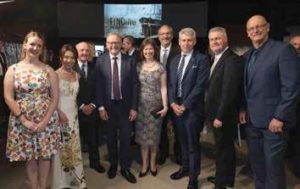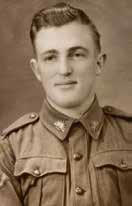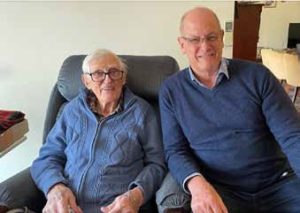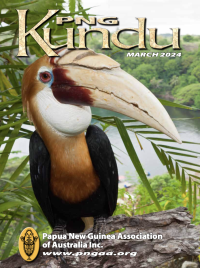MEMORIAL NEWS
Silentworld Foundation Commemorative Dinner with the Australian Prime Minister
A commemorative dinner was held on Monday 27 November 2023 in the Aircraft Hall at the Australian War Memorial in Canberra to honour all those who died when the Montevideo Maru was sunk on 1 July 1942. The dinner also acknowledged the Silentworld Expedition of April 2023 which successfully located the final resting place of the men of the Montevideo Maru, after nearly 81 years, providing great comfort to generations of relatives.
This special evening was hosted by John and Jacqui Mullen and the Silentworld Foundation.
Special guest-of-honour was the Prime Minister, Anthony Albanese, acknowledging the significance of the occasion. He was greeted by John and Jacqui Mullen as well as Director of the Australian War Memorial, Matt Anderson, before spending some time mingling with guests.
Guests included dignitaries from government, the military, representatives of other countries and Australian industry, together with a representative group of descendant families. Ray Martin was the Master of Ceremonies and ensured the evening flowed beautifully.
John Mullen welcomed everyone with a thoughtful speech that highlighted his enormous compassion for all those touched by this Australian and international disaster.
In the magnificent aviation hall of the AWM, guests were privileged to watch the powerful premiere of the outstanding short film by our amazing Max Uechtritz, ‘Finding the Montevideo Maru’. Hugely poignant and emotional, and reaching into the hearts of everyone present in honouring the courage and sacrifice of the men. It also showcased the expedition which found the Montevideo Maru in April 2023. At over 4,100 m down, the Montevideo Maru is deeper than the Titanic and visiting those depths is pushing the limits of even modern technology. As well, there were endless hours of calculations and planning.
The support by Australia’s Department of Defence and the Army’s Unrecovered War Casualties Unit, together with Fugro, the Dutch company which uses geo-data to unlock the secrets of the earth, and an international team of voluntary researchers, whose work and vast knowledge were critical to the success, was acknowledged.
Speeches were made by the Prime Minister, Chief of Army Lt Gen Simon Stuart, John Mullen and Andrea Williams.
Later in the evening, a presentation of a dossier containing all the data and images from the expedition was handed to Matt Anderson of the Australian War Memorial and to Daryl Karp of the Australian National Maritime Museum to be preserved as a permanent record in Australian history.
Finally, medallions were presented in recognition of the event to descendants and special guests as a permanent memory. It was a tradition in the 1700s and early 1800s that on the great voyages of discovery by the major seafaring nations in Europe, a medallion would be struck to commemorate the expedition and the brave men who sailed across the oceans.
Silentworld thought that it would be nice to replicate that tradition, and so they thoughtfully considered so many of the aspects that came together in this story, and made some medallions in the same style to record and remember the Montevideo Maru and all those who lost their lives.
I was privileged to sit between the Prime Minister and Chief of Navy, Rear Admiral Mark Hammond, and it was especially enjoyable to join other members of the Silentworld Montevideo Maru Expedition team—John Mullen, Max Uechtritz, Neale Maude, Captain Roger Turner (RN Rtd) and Commodore Tim Brown (RAN retd), as well as many who had worked ‘behind the scenes’.
That the Prime Minister Anthony Albanese, various defence chiefs and departmental heads, and seven ambassadors wanted to be present, says to the descendants that Australia does now care.
It was an important and much-appreciated evening and a salute to the victims and their families…a wonderful evening of commemoration and celebration.
Andrea Williams
Note: Both Max Uechtritz and Andrea Williams were privileged to be part of the five-year expedition planning and the search itself on the state-of-the-art vessel Fugro Equator.
Barney Cain VX3069
Final salute: 103-year-old digger Barney Cain, last survivor from the Fall of Rabaul, dies after honouring his fallen mates in PM dinner video. It was almost as if Barney held on to give one last final, sombre salute to lost mates.
And what a stylish cameo send-off it was: there on a huge screen in front of the Prime Minister, Chief of Army, Chief of Navy and multiple international ambassadors at a commemorative dinner at the Australian War Memorial.
It was to be his final bow. A few hours later Barney Cain VX3069 slipped away. He was the last survivor of the first WWII attack on Australian territory—the Japanese invasion of Rabaul on 23 January 1942.
He was the last person to see alive the nearly 1,000 Australians who perished aboard the prison ship MV Montevideo Maru in our greatest maritime disaster.
So, who better to feature in a documentary I’d made for a special dinner for descendant families of those poor souls. An event hosted by John Mullen, the Silentworld Foundation chairman who’d led our expedition to finally locate the wreck and war grave of the ship at a depth deeper than the Titanic in April this year.
Meeting Barney Cain was a privilege
It was a privilege for cinematographer, Neale Maude, and me to meet and interview Barney in May when he still, defiantly, lived independently in his own home on the Mornington Peninsula.
And fun! A renowned wise-cracker, Barney had us in stitches at times.
‘Deaf as a beetle!’ … he roared and laughed at himself repeatedly as his son, Dennis and daughter-in-law, Yvonne, relayed questions via instant text transcripts on the iPhone.
Then, we’d struggle with our emotions along with Barney when he talked about the mates who never managed to escape from Rabaul like he did when the order went out ‘every man for himself’.
oist eyes among the 140 dinner guests as they watched Barney falter ever so slightly then sink into silence, his eyes and face momentarily a haunting kaleidoscope of grief, memories and what he saw as the sheer folly of war.
Neale and I listened in awe as Barney described his 78-day escape ordeal through jungle, over mountains and across croc-infested rivers dodging Japanese hunting them from land, sea and air. Before finally being plucked from a plantation beach by a rescue boat, Barney had suffered intense malaria, dysentery and malnutrition. His clothes and boots rotted off and giant leeches sucked his blood. His soul was shattered when he saw others die or give up, surrendering to the Japanese in the hope of food, rest and the Geneva Convention.
‘We didn’t have a bloody chance,’ Barney said about his under-equipped, out-gunned Lark Force of 1,400 when a massive Japanese fleet (fresh from Pearl Harbour) sailed into Rabaul Harbour disgorging thousands of troops and hundreds of warplanes from aircraft carriers.
As his ailments worsened during what was one of the greatest escape treks in Australian history, Barney felt he had about two weeks of life left in him.
His health was nearly a moot point when he rounded a corner near a plantation called Tol. He and his mates saw some barges, as he’d recounted previously.
Barney remembers the moment the Japanese arrived as if it was yesterday.
‘There were a lot of troops there, all in these small parties, and a Major Bill Owen was organising to get everyone over to the other side of the river,’ he said.
‘The natives were going to ferry us across in canoes, and around the corner came these barges.
‘Someone said, “They’ve come to rescue us,” but I had a pair of binoculars, and I won’t tell you what I said first, then said, “No, they’re Japanese,” and they let us know then. Boom, boom, boom. They started firing—I think they were mortars—and it scattered the natives, so they abandoned us, and took off in the canoes.’
Amid a hail of fire, Barney’s bunch took off into the hills. About 160 other Australian soldiers and civilians were captured that dreadful day at Tol and were brutally killed in what’s known as the Massacre of Tol and Waitavolo.
One man who’d been bayoneted 11 times and left for dead—Private Billy Cook—crawled out of the jungle to join Barney’s group in what was the most incredible of survival stories.
See more HERE
Max Uechtritz
Special Article
Congratulations to Gayle Thwaites who has had a special article printed as the lead story in Melbourne’s Shrine of Remembrance Magazine, Remembrance, in November 2023. It was titled ‘Remembering Jock: Find Closure in the Wreckage of the MV Montevideo Maru’. We hope to be able to bring it to you next issue.
Anzac Day and the Rabaul & Montevideo Maru Education Program
There is an excellent education program on the Rabaul and Montevideo Maru website, designed by history teachers, which can be taught in one or more lessons—in the lead up to Anzac Day, and one year after the Montevideo Maru was found. Please share to your local schools and encourage any support by telling your story, and please let us know which schools you are speaking with! Queries to education@montevideo-maru.org OR https://montevideo-maru.org/education/
Patrick Bourke has advised that RSL Australia has now included the Montevideo Maru in its Key Commemorative Dates: https://www.rslaustralia.org/key-commemorative-dates
Anzac Day, Rabaul 2024
A number of people have expressed an interest in travelling to Rabaul for Anzac Day 2024.
The visit will be a combination of Lark Force members and any others who would like to visit Rabaul/Kokopo. Are you keen to join? Let us know!
There will be several formal events including a dusk service at the Montevideo Maru Monument on Rabaul’s Simpson Harbour in the late afternoon of Wednesday, 24 April, and traditional Anzac Day Service and Gunfire Breakfast on Thursday, 25 April.
It is also hoped that there will be a service later that day at Bitapaka but that is to be confirmed.
Descendants of Lark Force will be travelling to Tol Plantation to instal and unveil a story board commemorating the WWII history at Tol. The plan is to do this during a school day (likely Tuesday,
23 April) so that the students from the 2/22nd Lark Force Tol High School can also participate.
Those already booked are travelling to Rabaul the weekend before, or on Monday 22 April and returning the following Friday and Saturday or Sunday, although a few will be staying a bit longer. There will be opportunities to see the many sites around the Gazelle Peninsula.
Whilst it may be best for everyone to book their own airfares and accommodation, there may be an opportunity for group travel.
Anyone interested, please keep in touch with:
Marg Curtis at Lark Force Association marglcurtis@outlook.com, John Reeves at neradaq@gmail.com or Andrea Williams at PNGAA—Rabaul & Montevideo Maru group, admin@montevideo-maru.org






